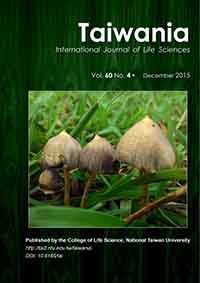Research Paper
Classifying Taiwan Lianas with Radiating Plates of Xylem
Sheng-Zehn Yang and Po-Hao Chen
Published on: 15 December 2015
Page: 151 - 159
DOI: 10.6165/tai.2015.60.151
Abstract
Radiating plates of xylem are a lianas cambium variation, of which, 22 families have this feature. This study investigates 15 liana species representing nine families with radiating plates of xylem structures. The features of the transverse section and epidermis in fresh liana samples are documented, including shapes and colors of xylem and phloem, ray width and numbers, and skin morphology. Experimental results indicated that the shape of phloem fibers in Ampelopsis brevipedunculata var. hancei is gradually tapered and flame-like, which is in contrast with the other characteristics of this type, including those classified as rays. Both inner and outer cylinders of vascular bundles are found in Piper kwashoense, and the irregularly inner cylinder persists yet gradually diminishes. Red crystals are numerous in the cortex of Celastrus kusanoi. Aristolochia shimadai and A. zollingeriana develop a combination of two cambium variants, radiating plates of xylem and a lobed xylem. The shape of phloem in Stauntonia obovatifoliola is square or truncate, and its rays are numerous. Meanwhile, that of Neoalsomitra integrifolia is blunt and its rays are fewer. As for the features of a stem surface within the same family, Cyclea ochiaiana is brownish in color and has a deep vertical depression with lenticels, Pericampylus glaucus is greenish in color with a vertical shallow depression. Within the same genus, Aristolochia shimadai develops lenticels, which are not in A. zollingeriana; although the periderm developed in Clematis grata is a ring bark and tears easily, that of Clematis tamura is thick and soft.
Keyword: Cambial production unit, lianas, single cambium activity, xylem in plates.


